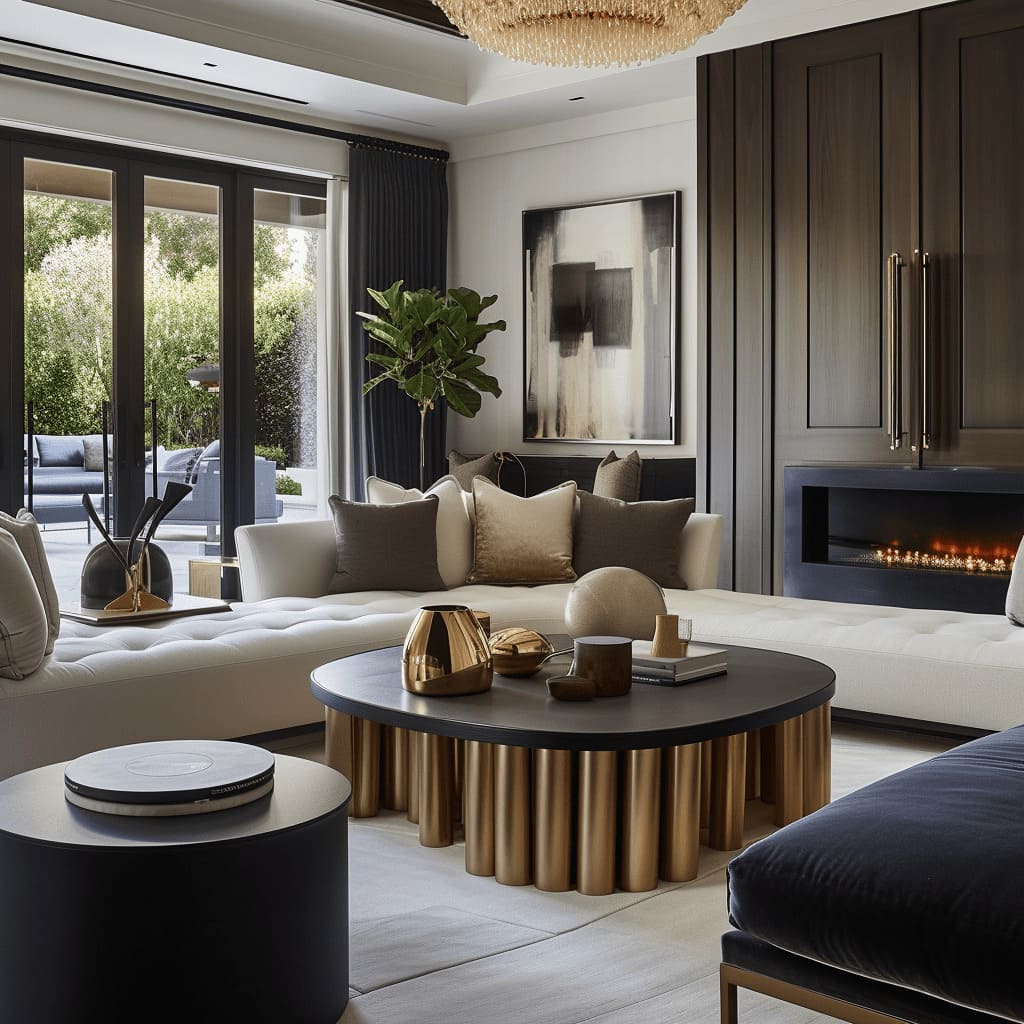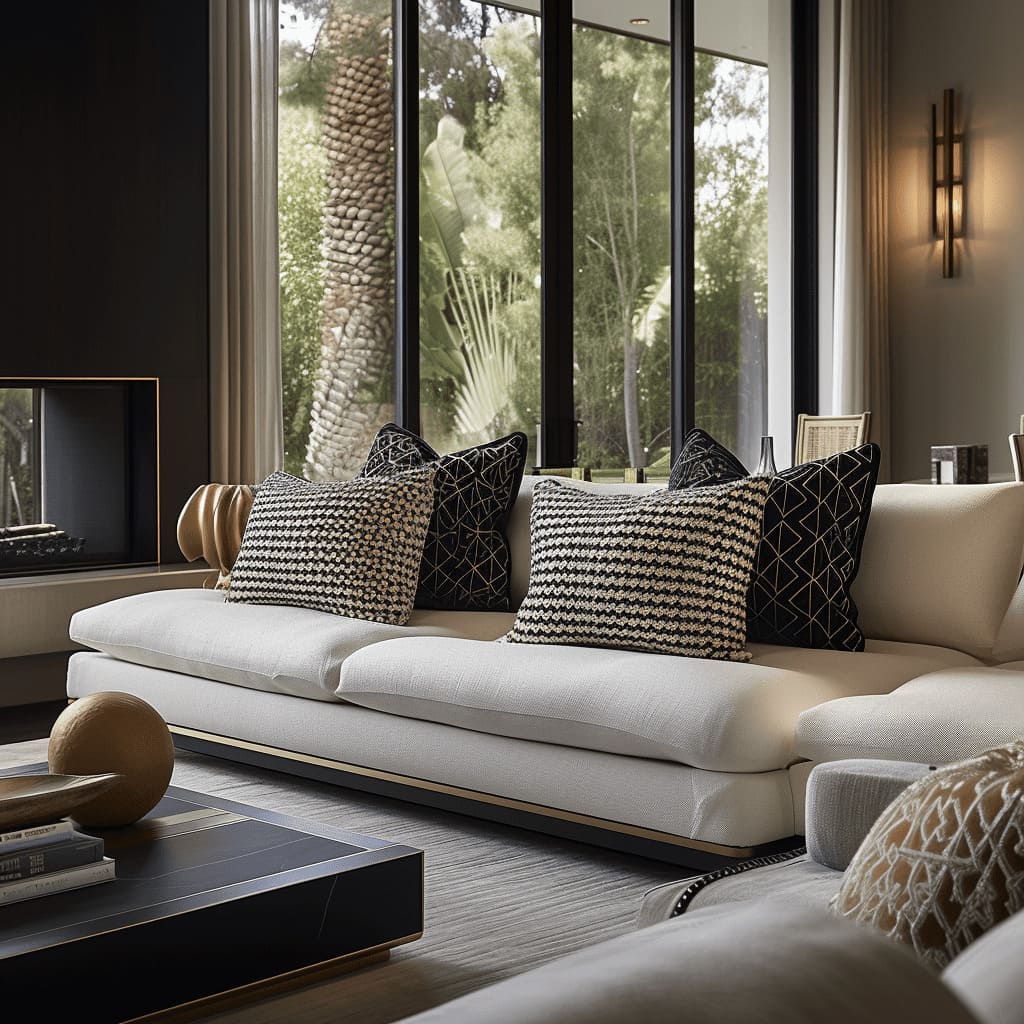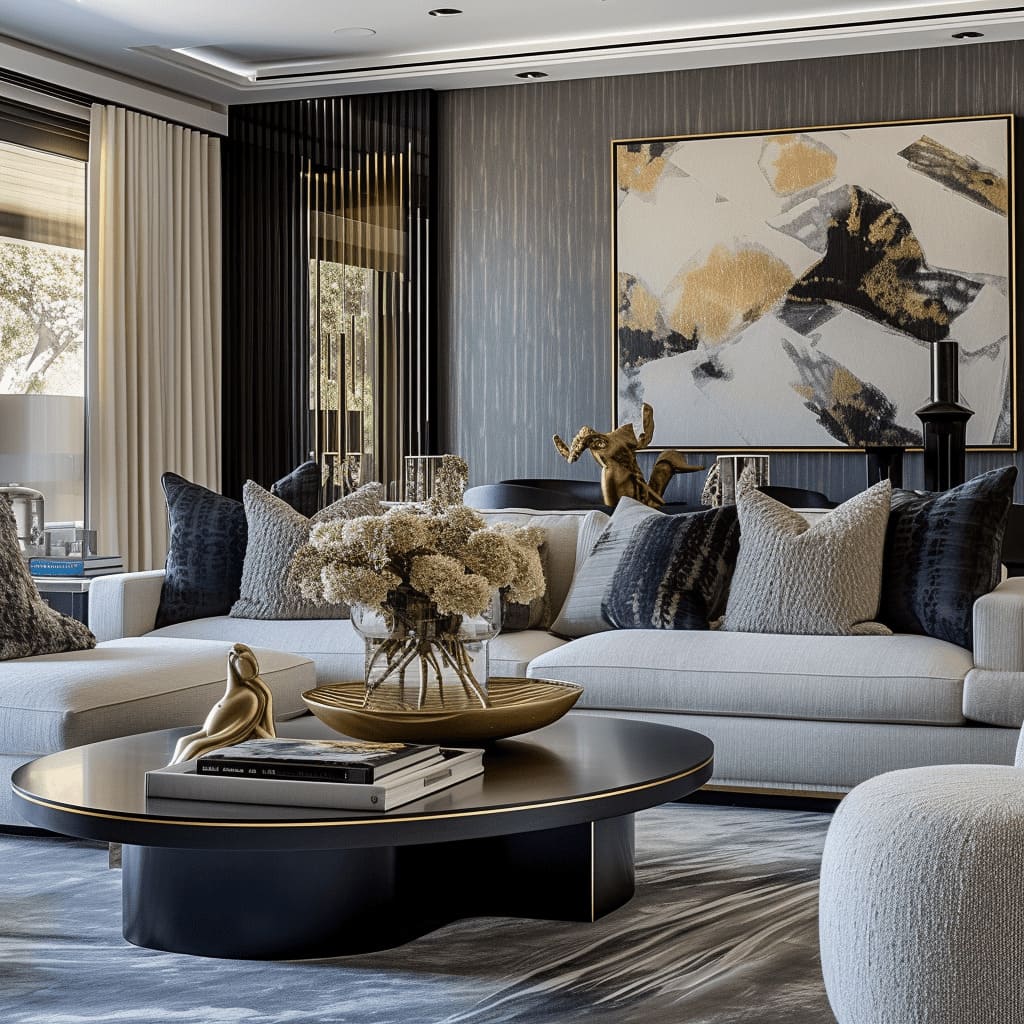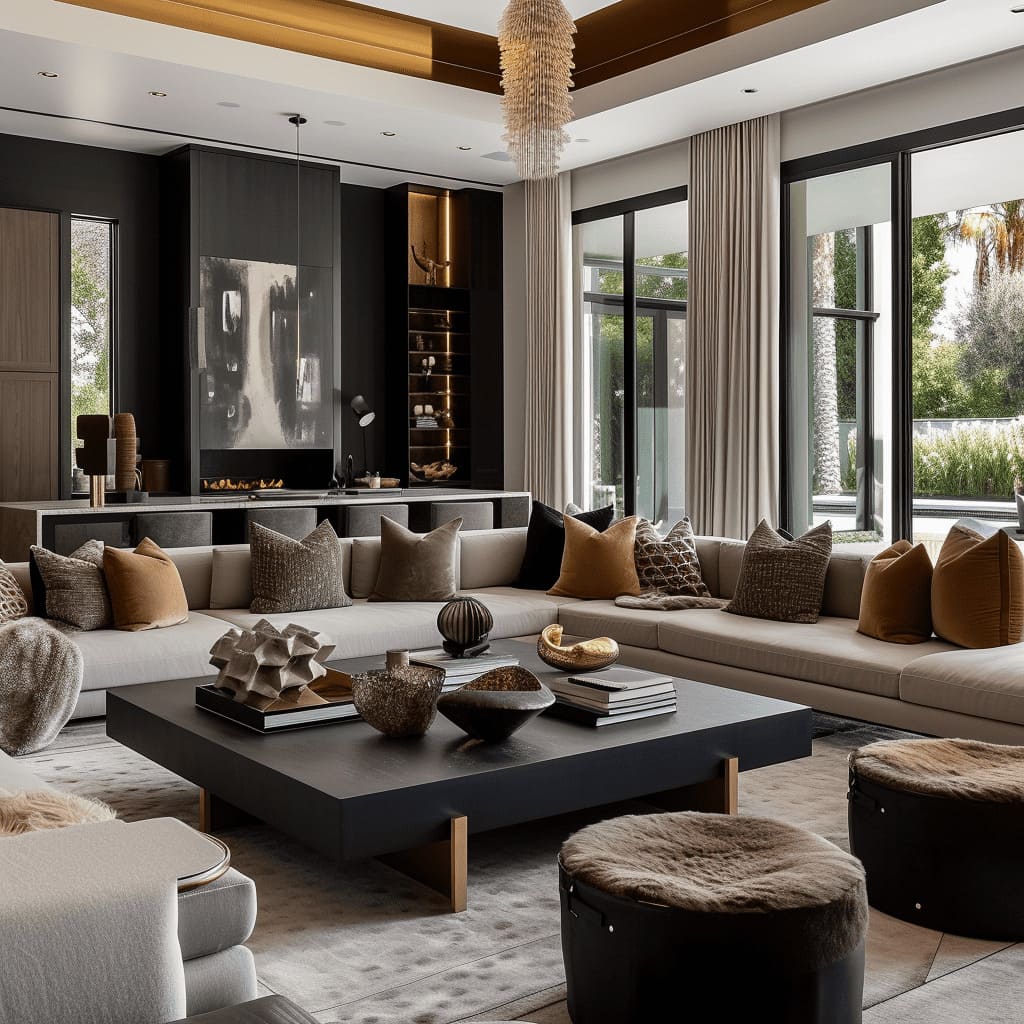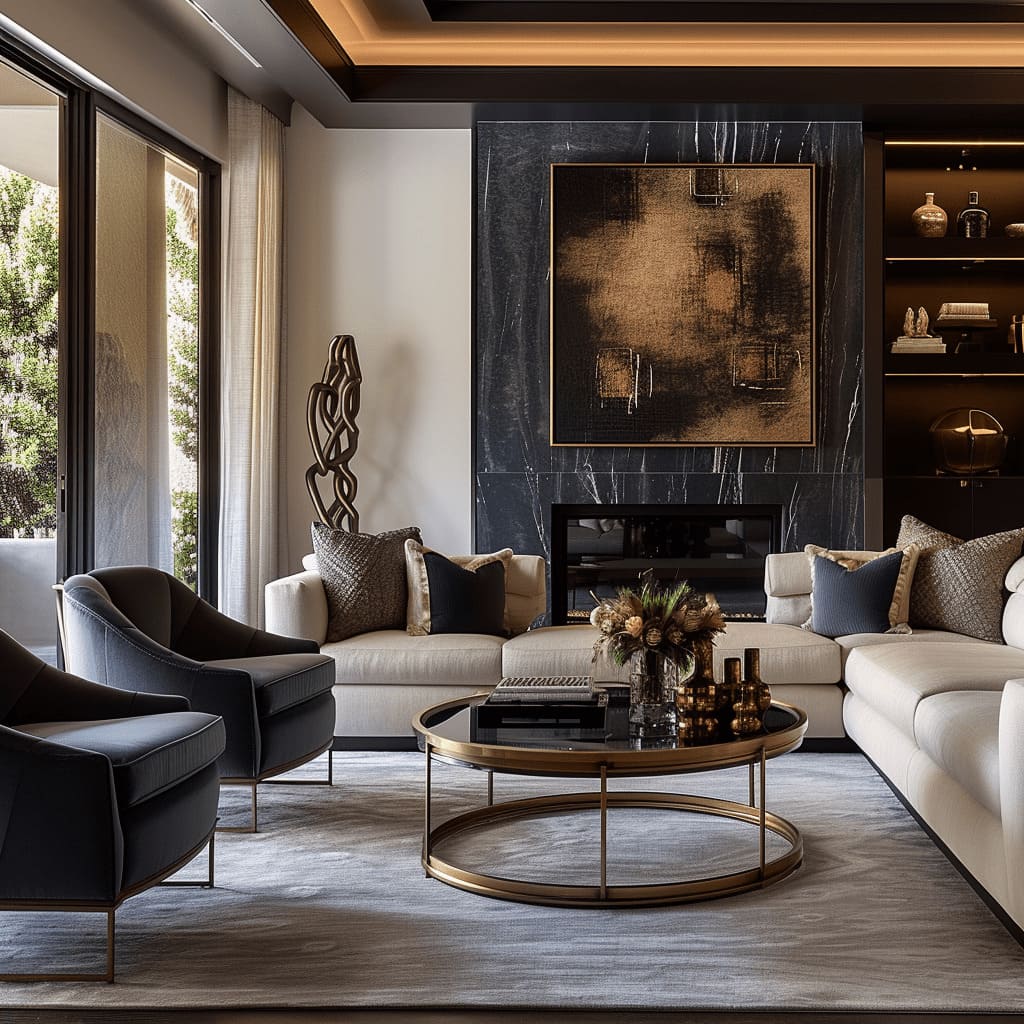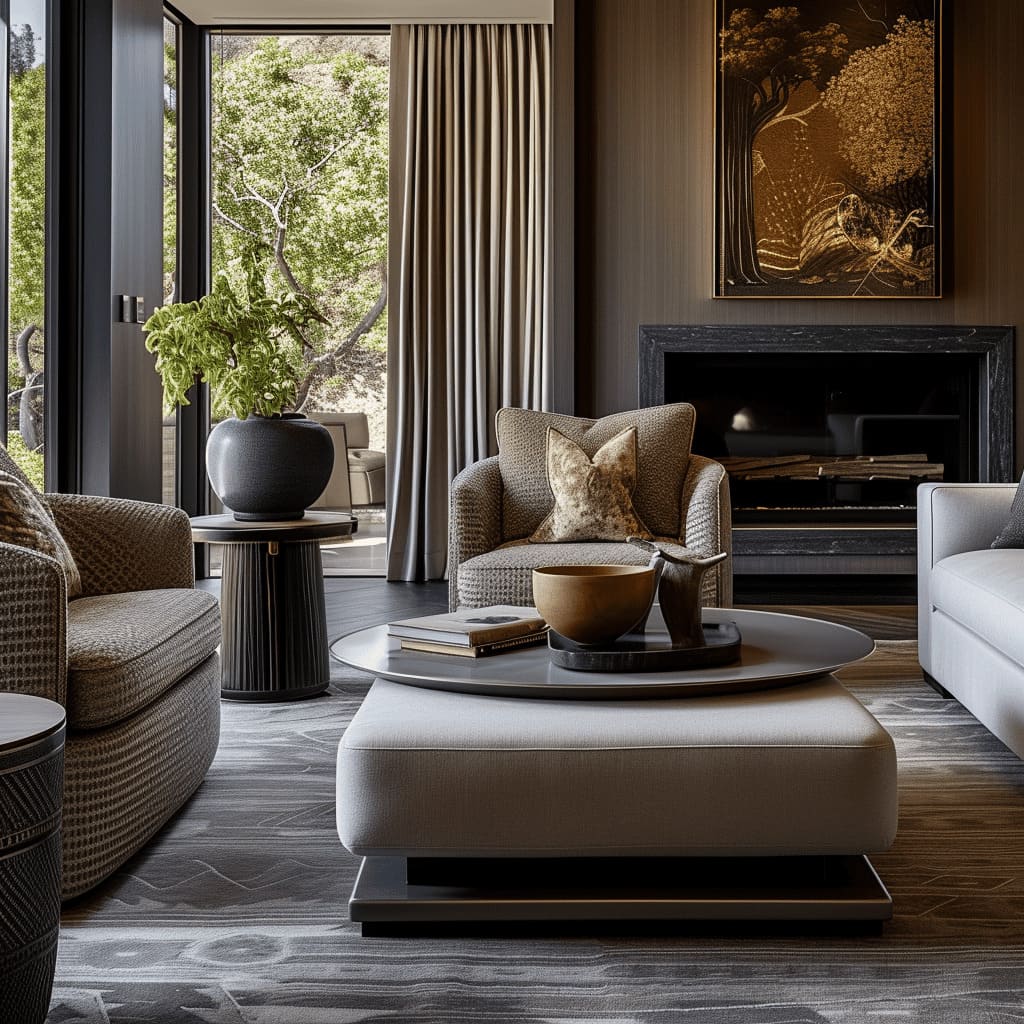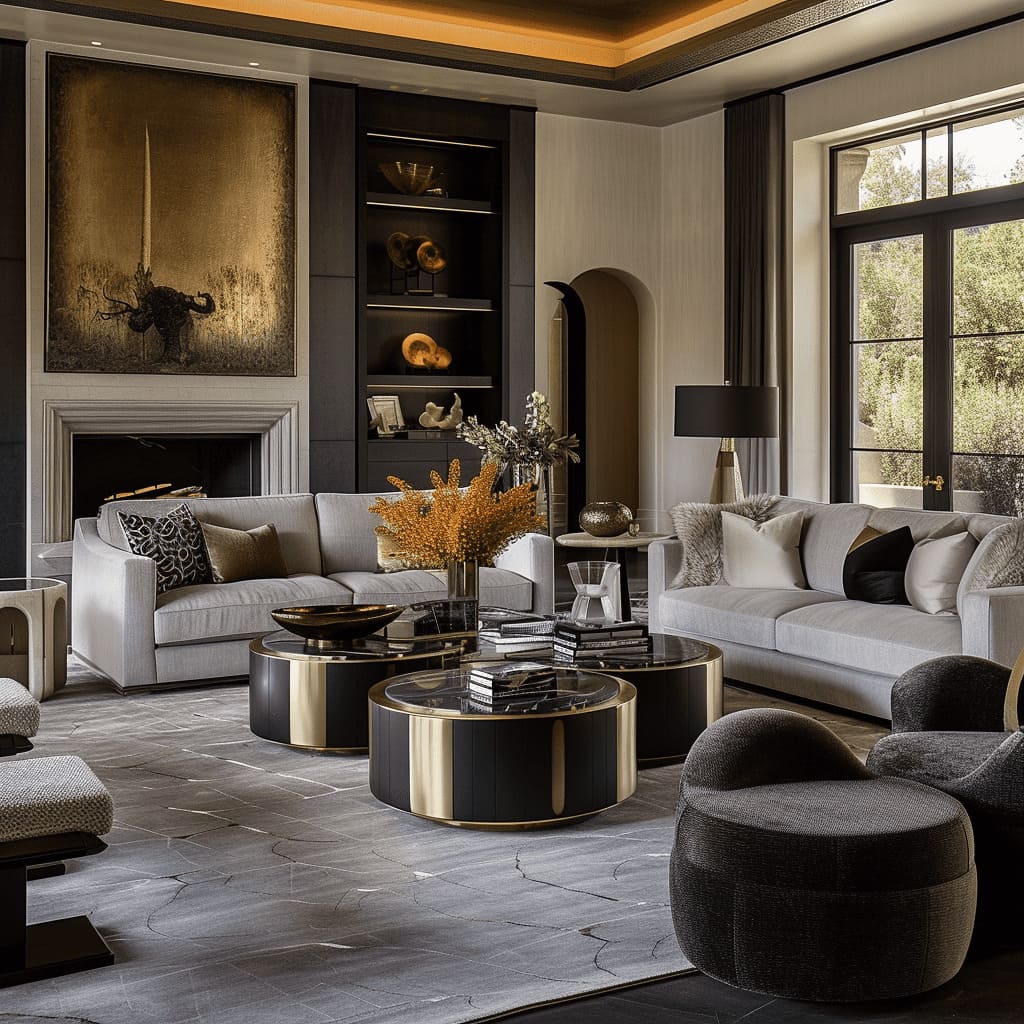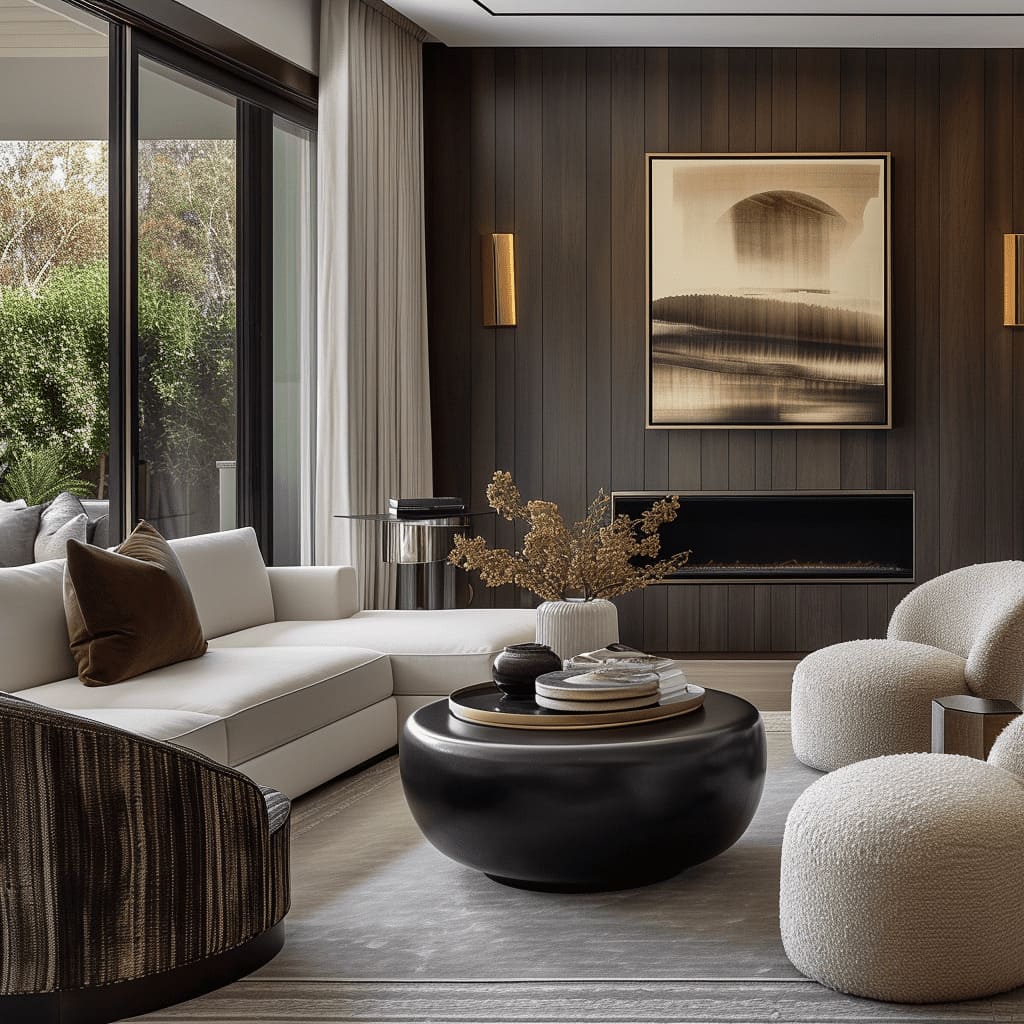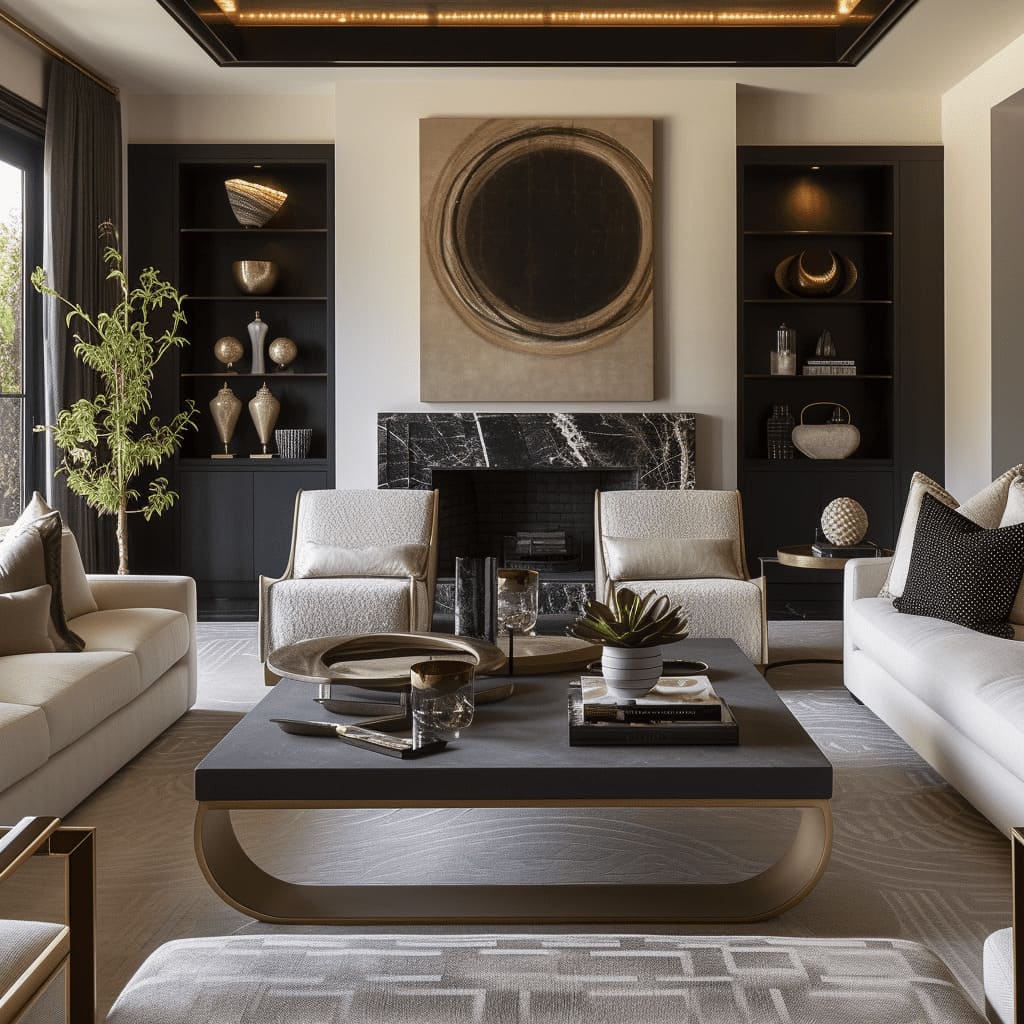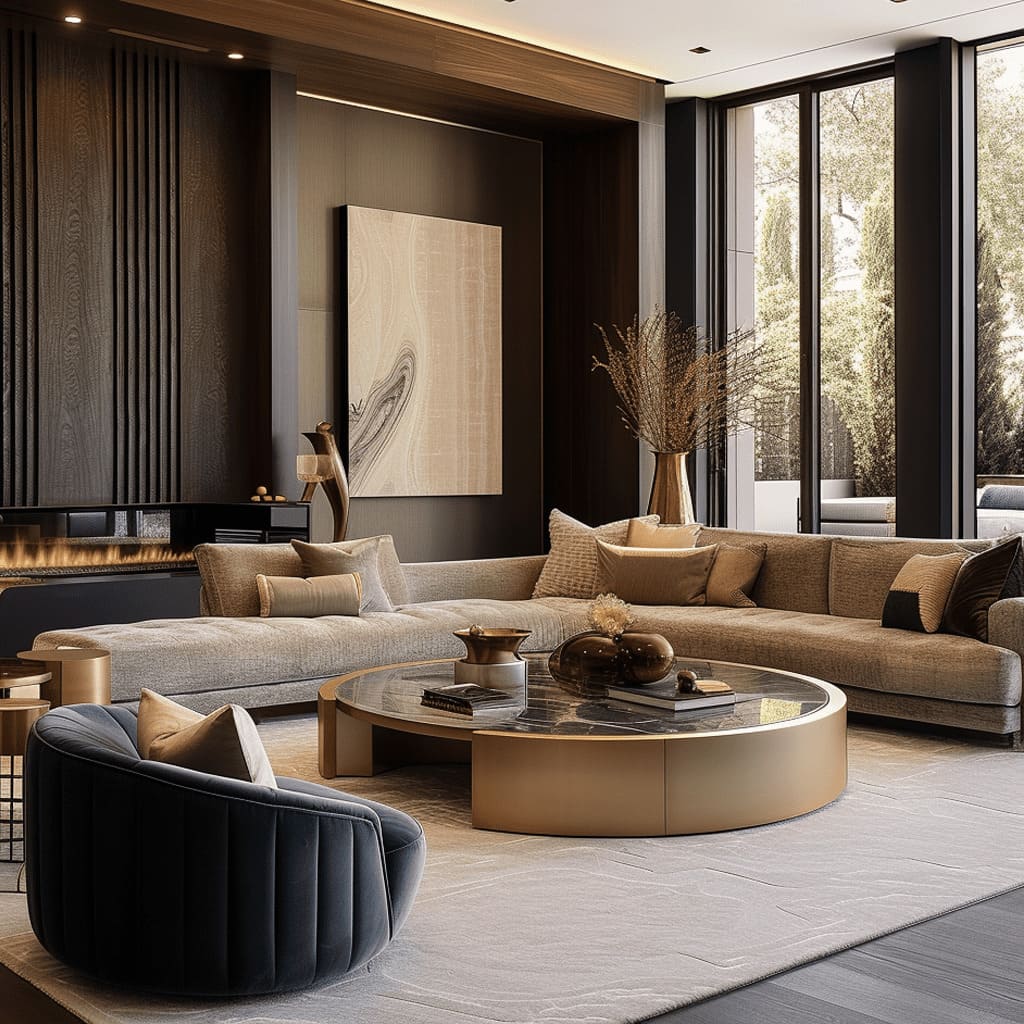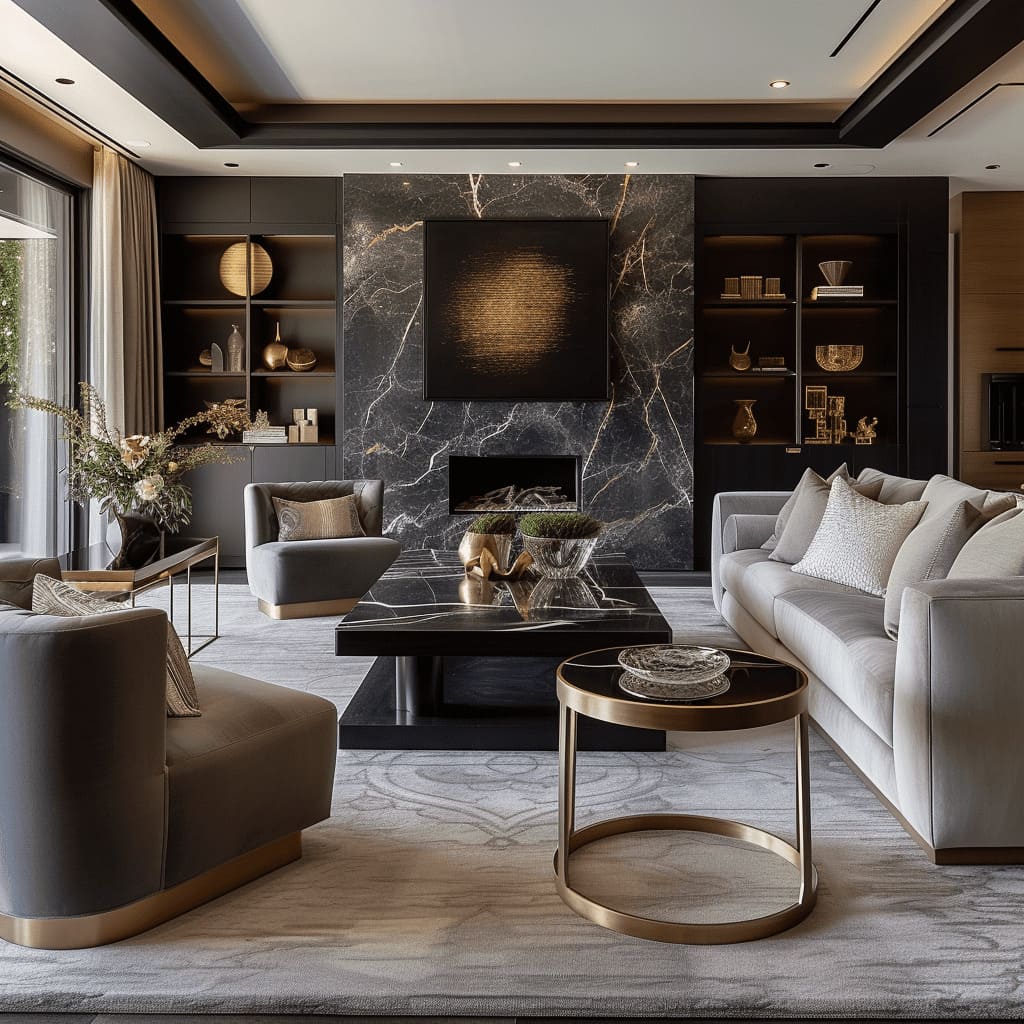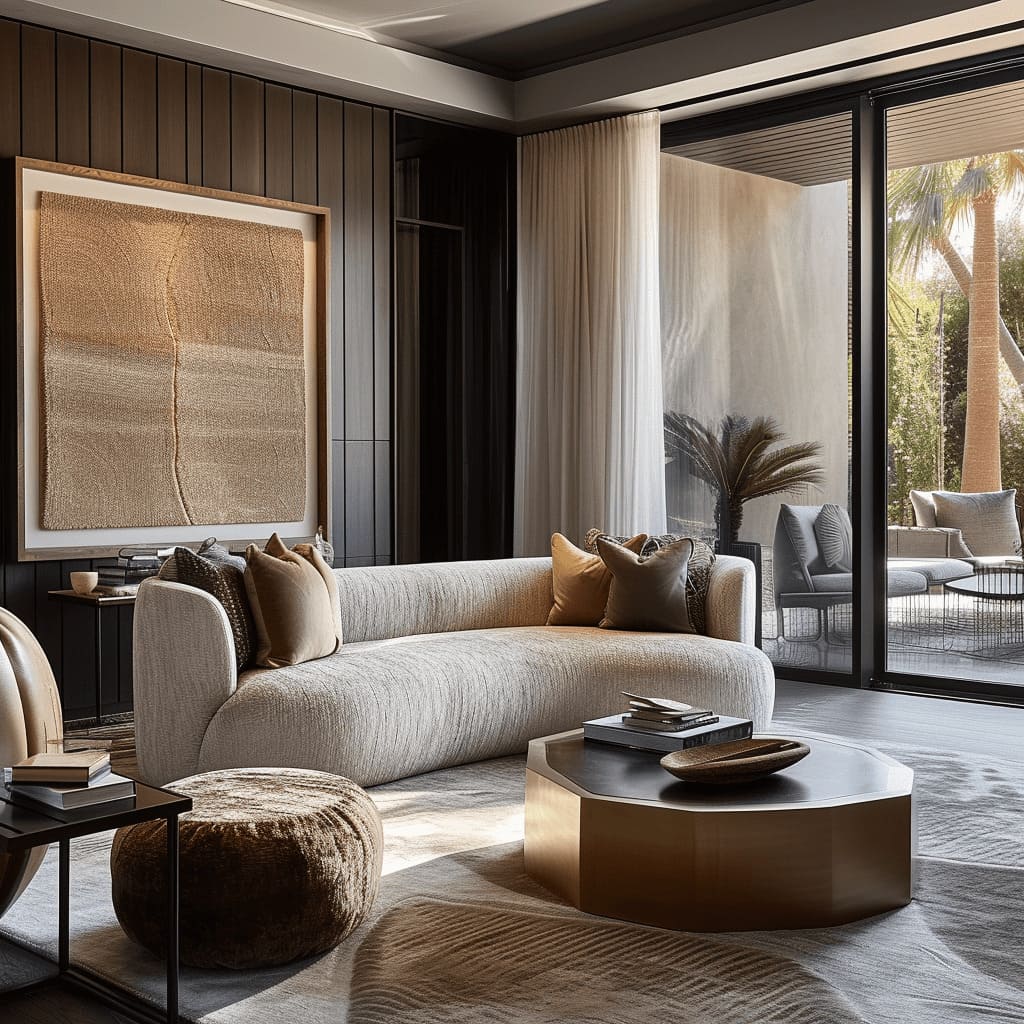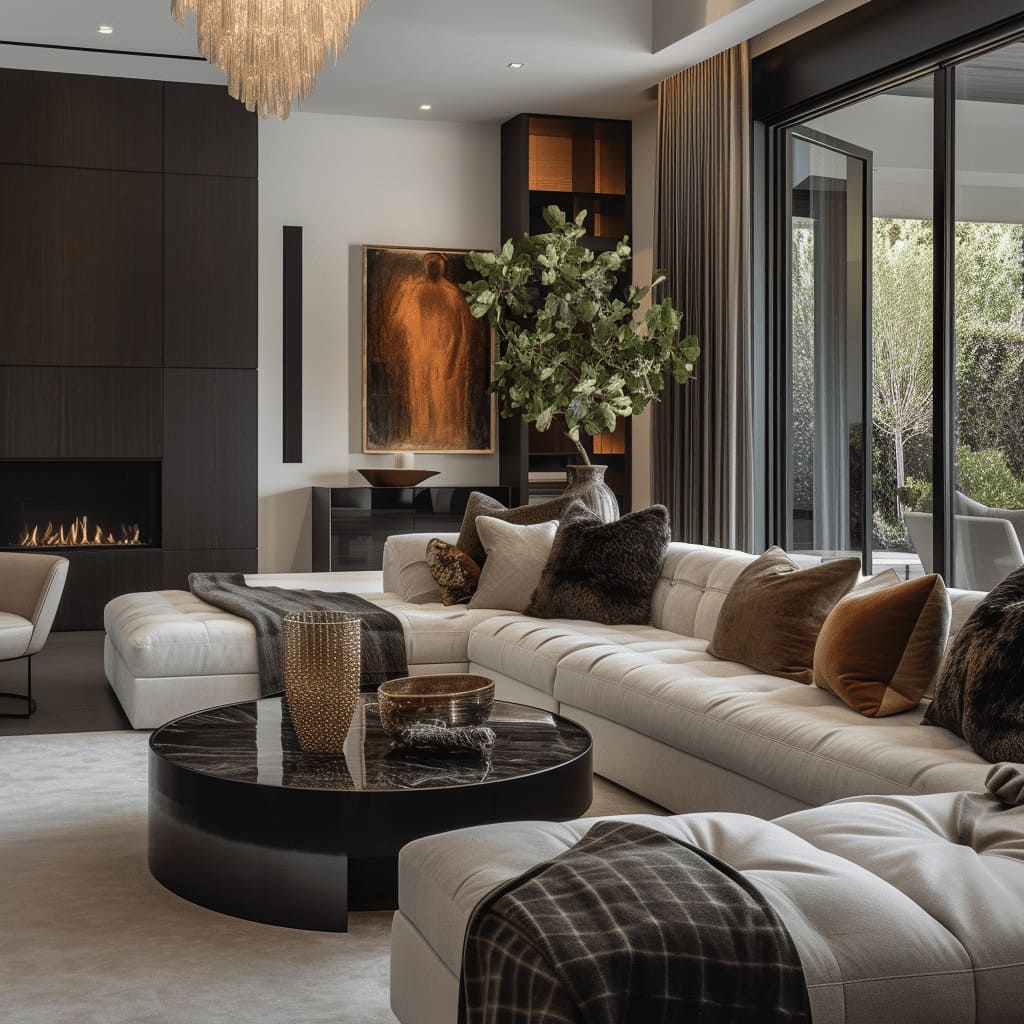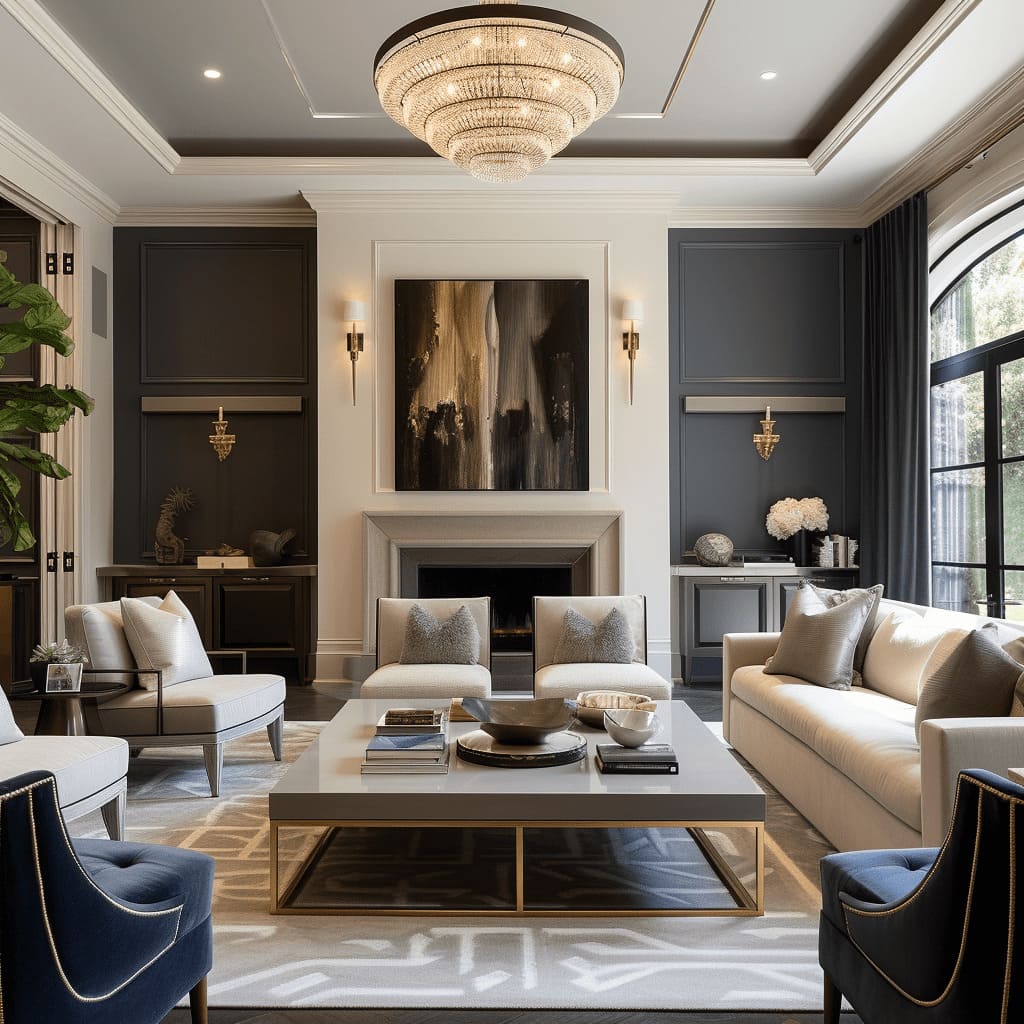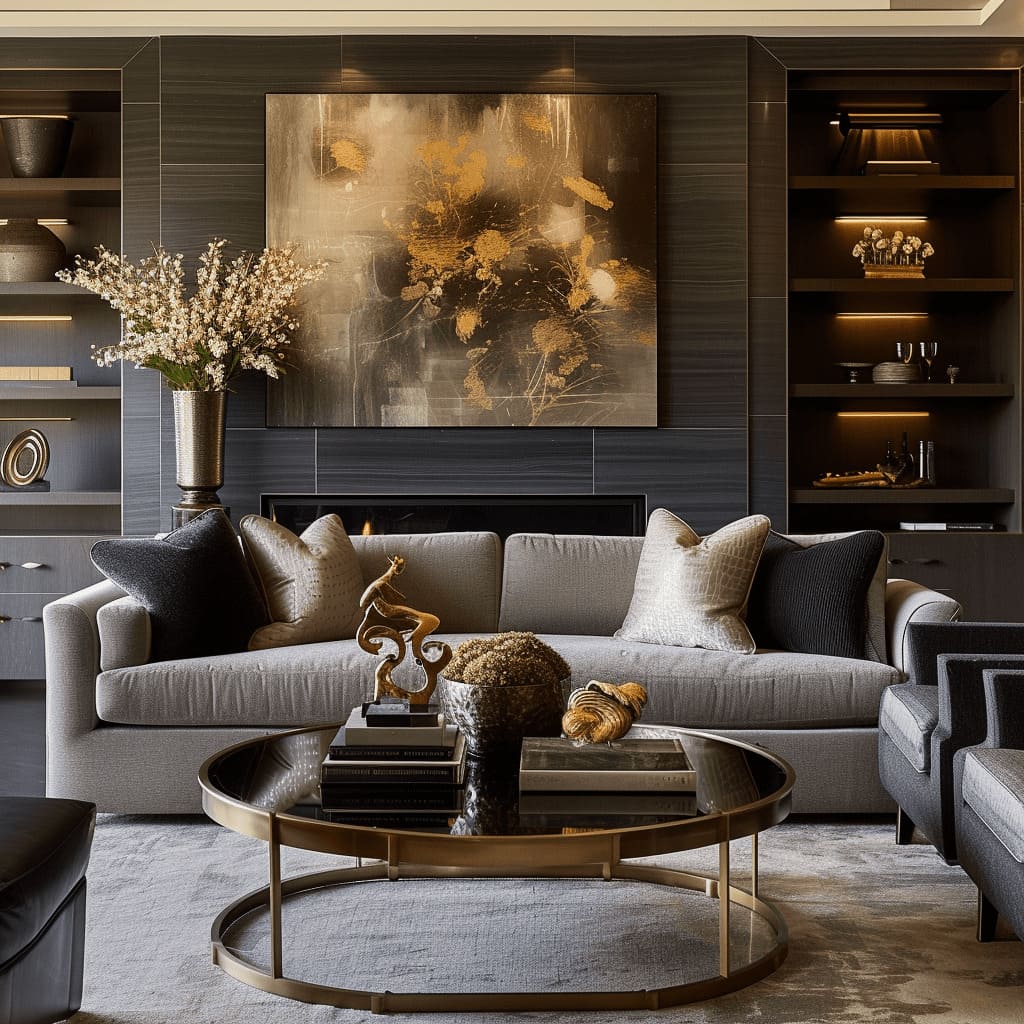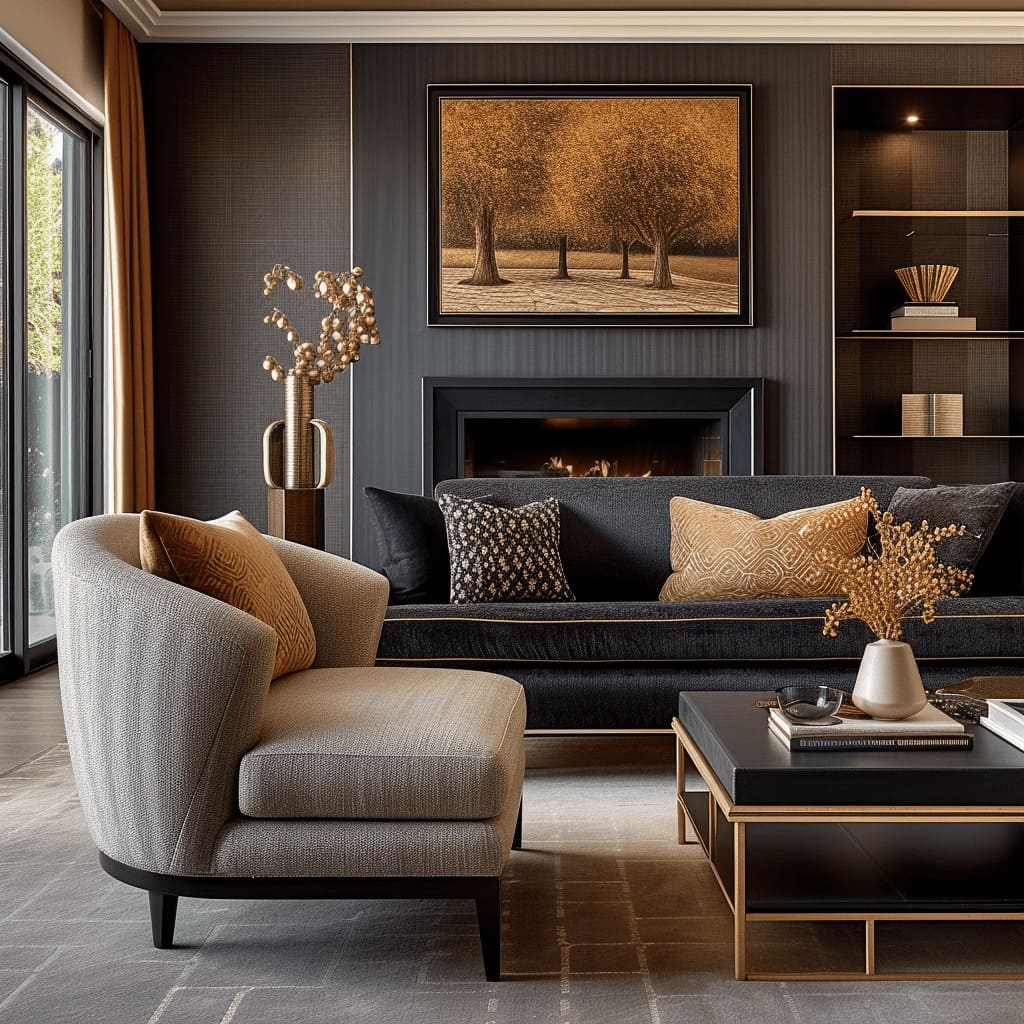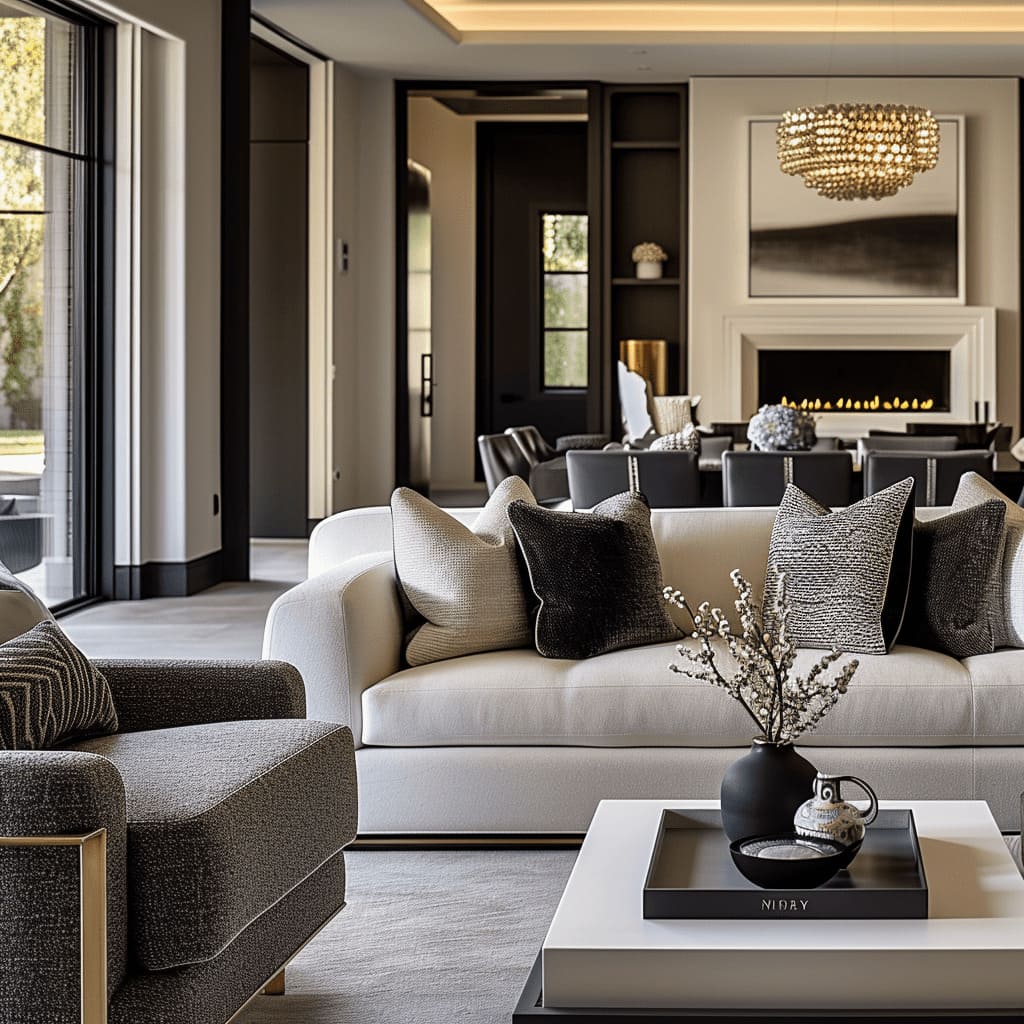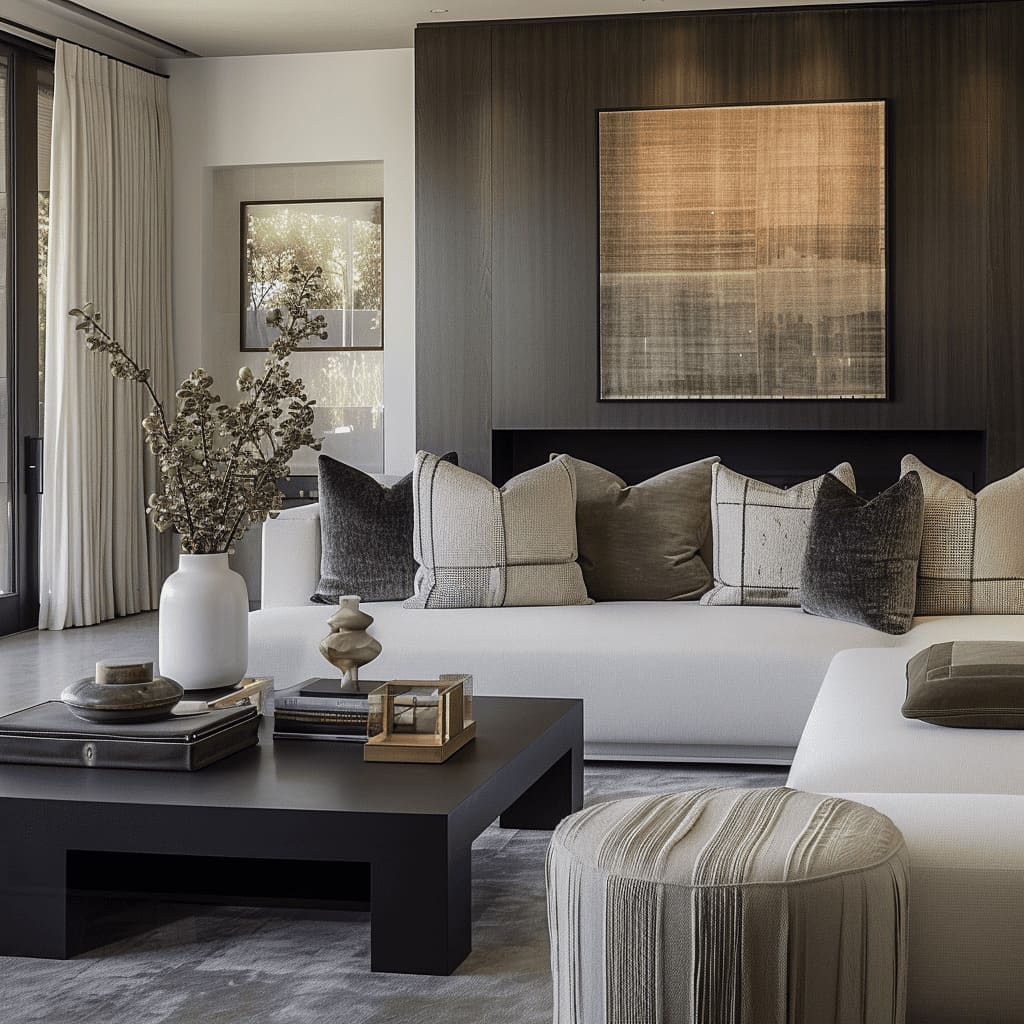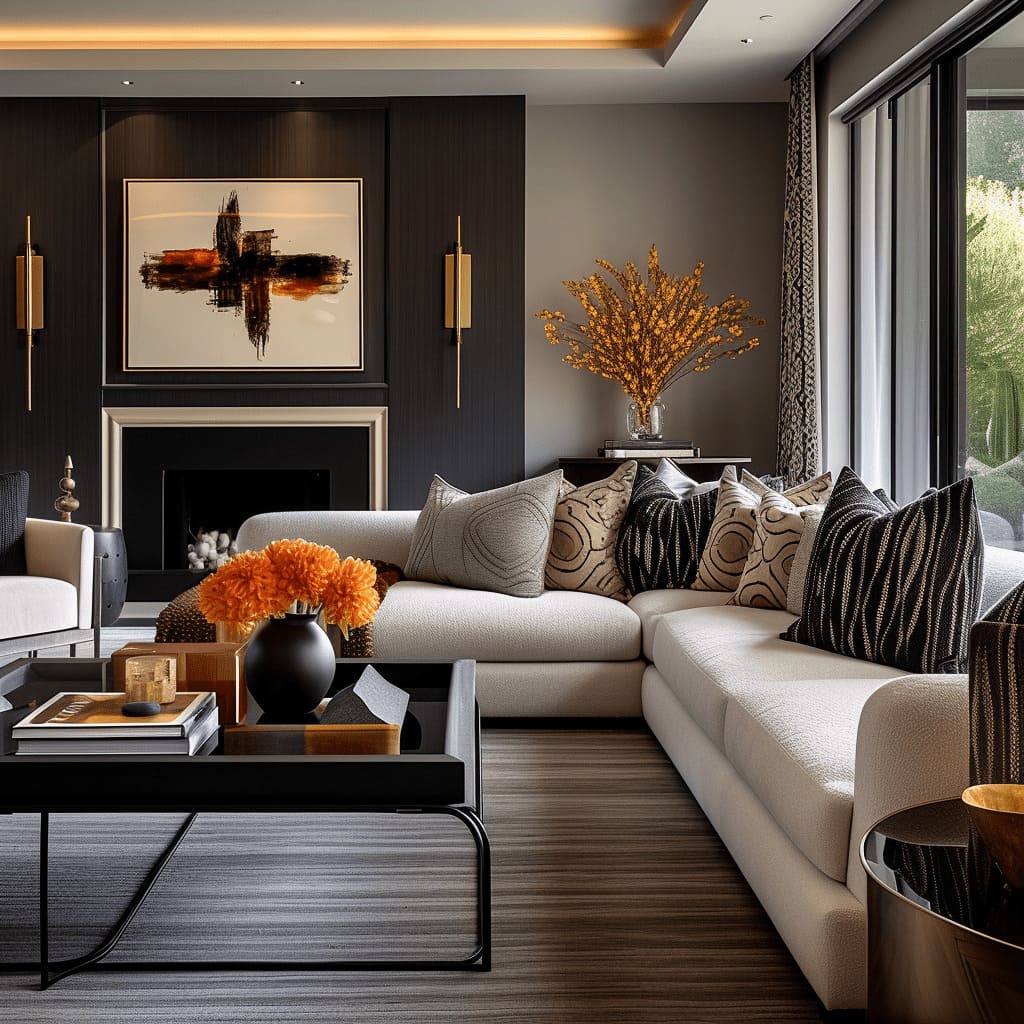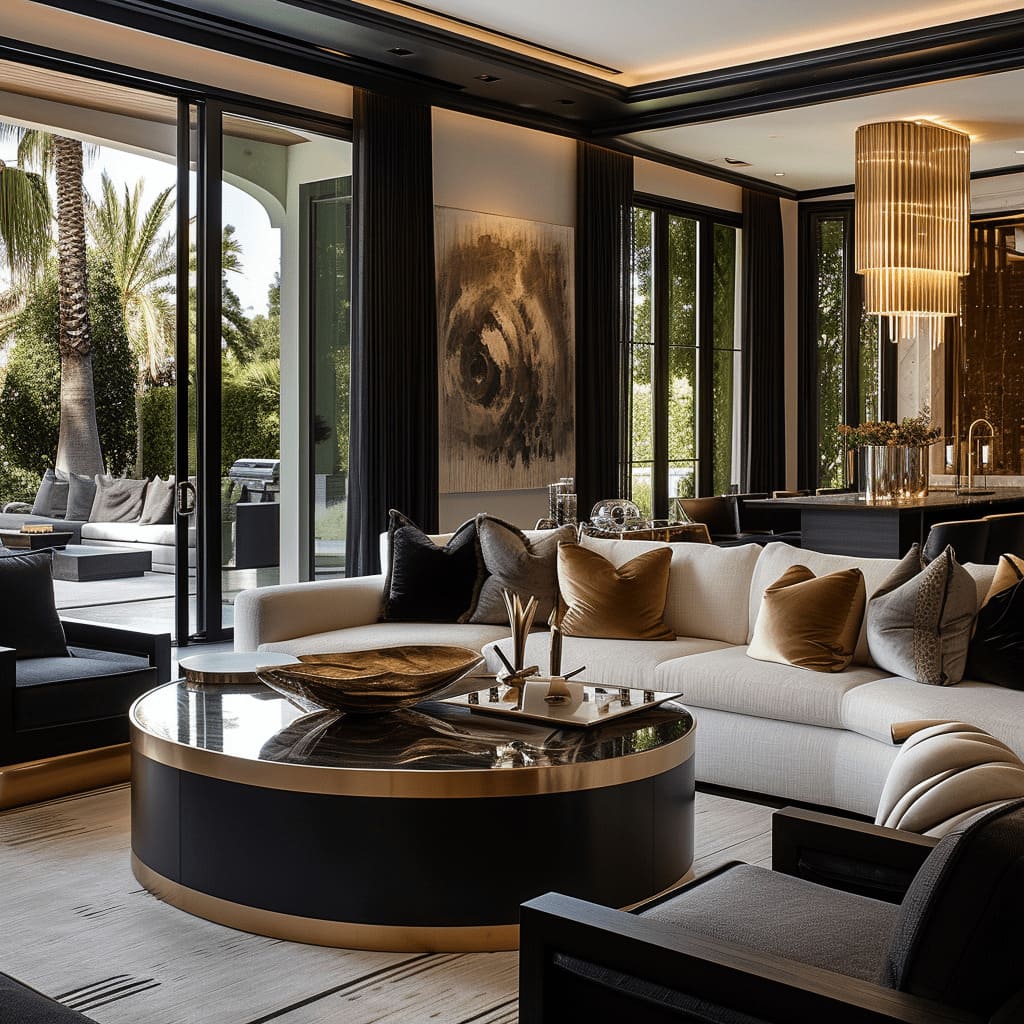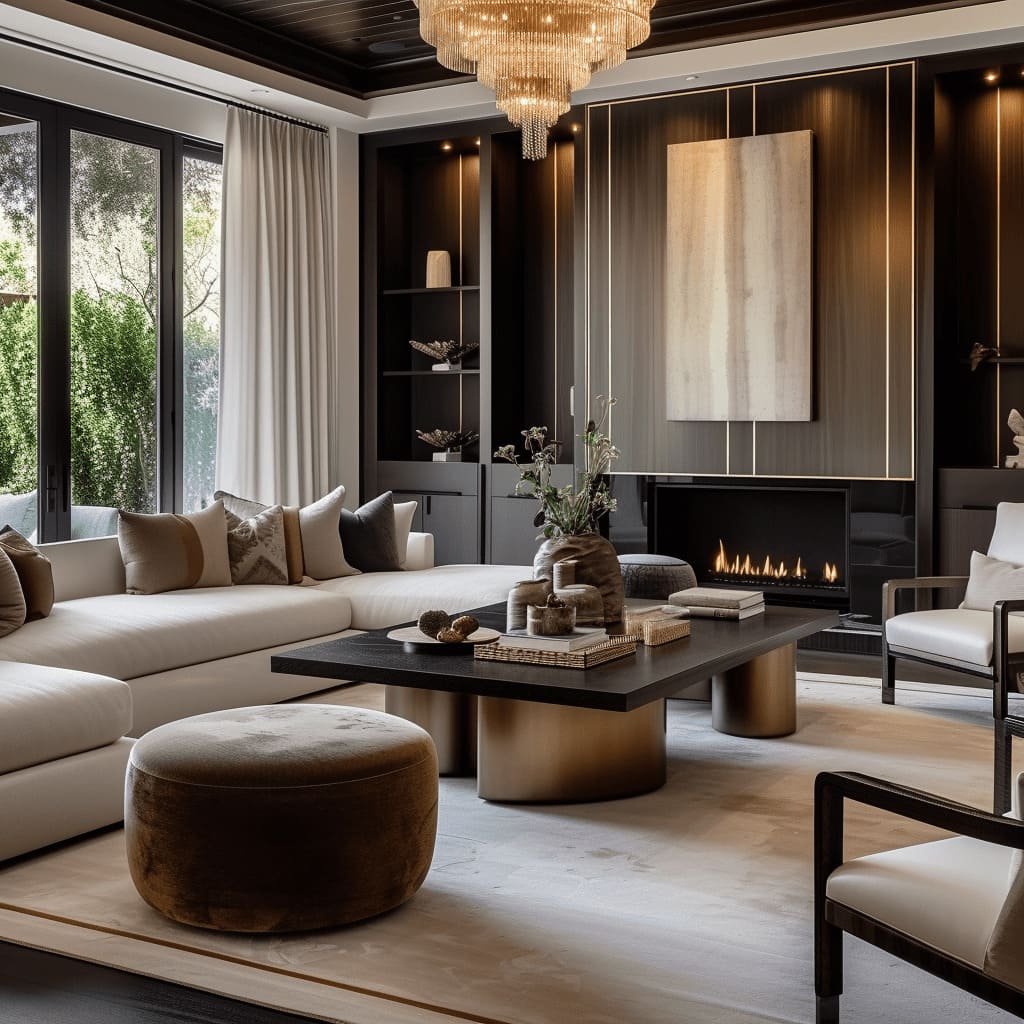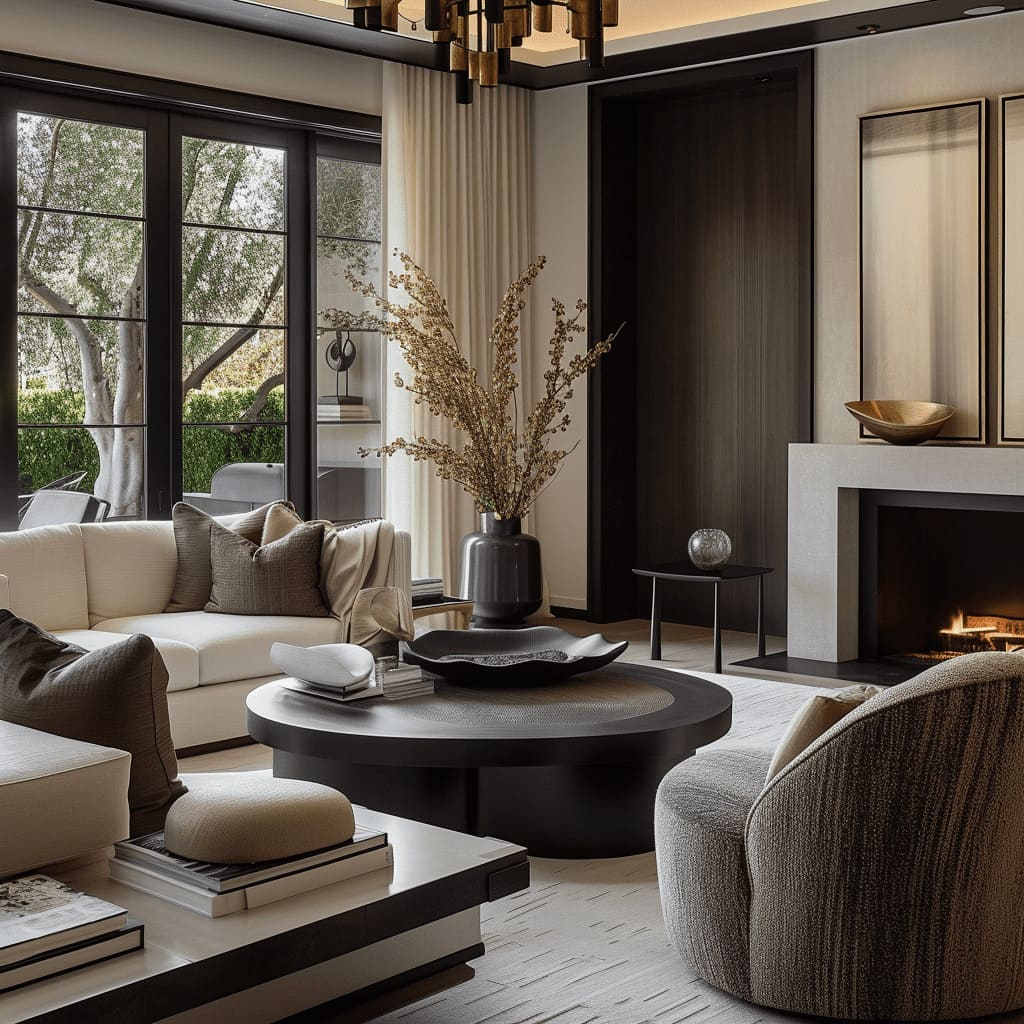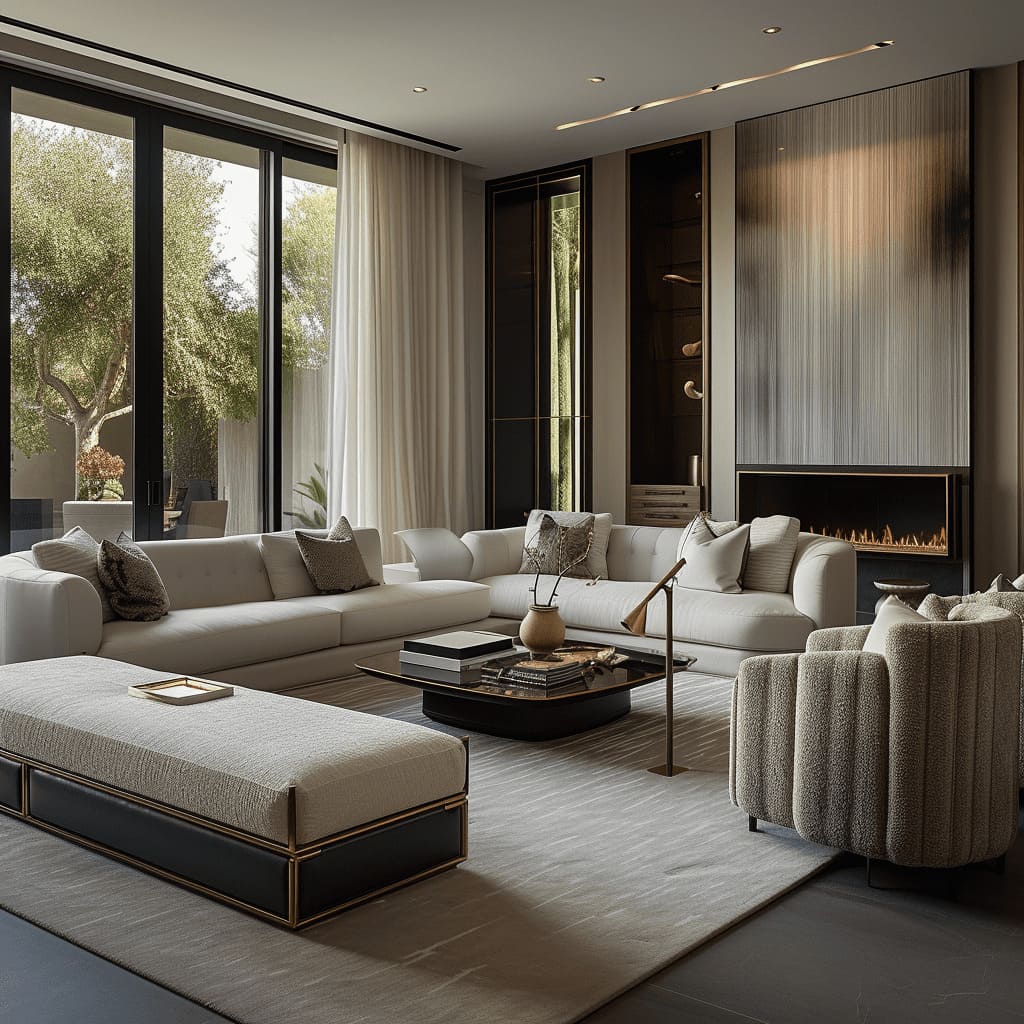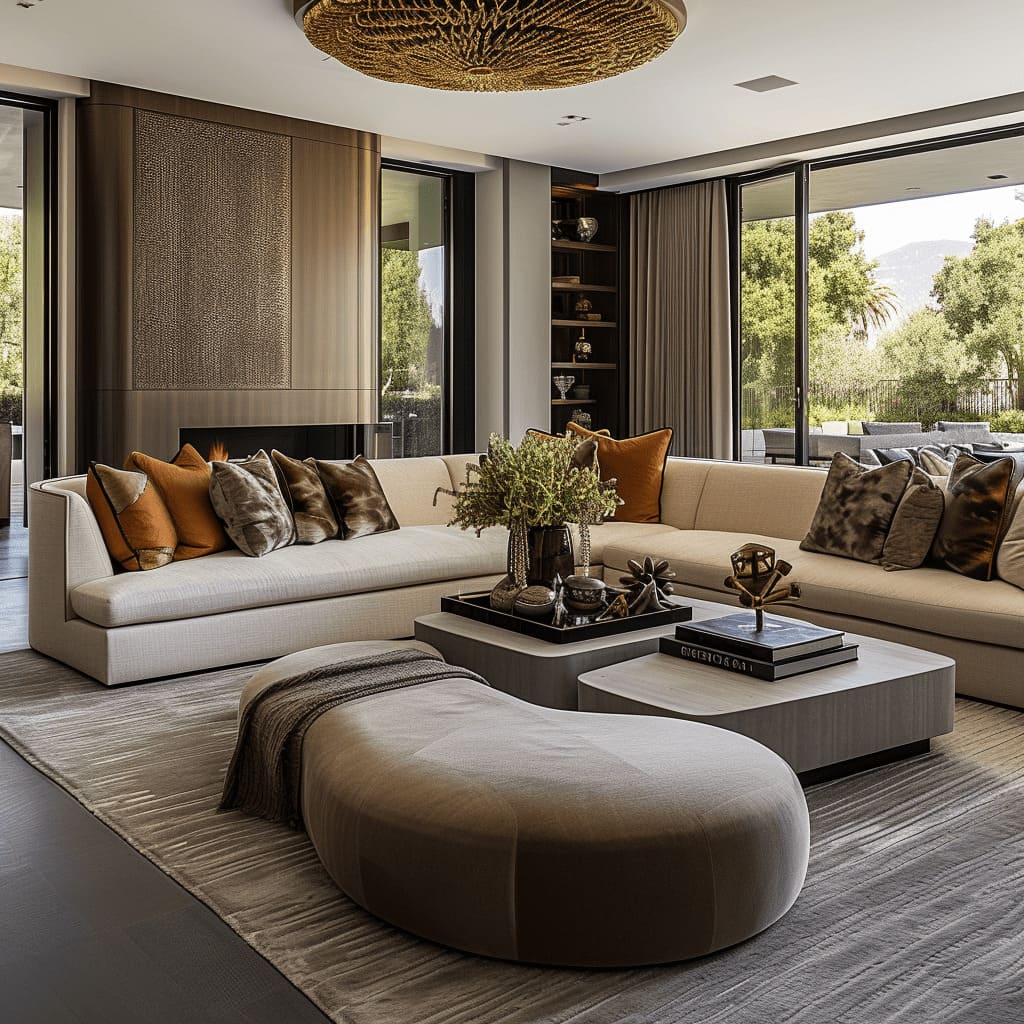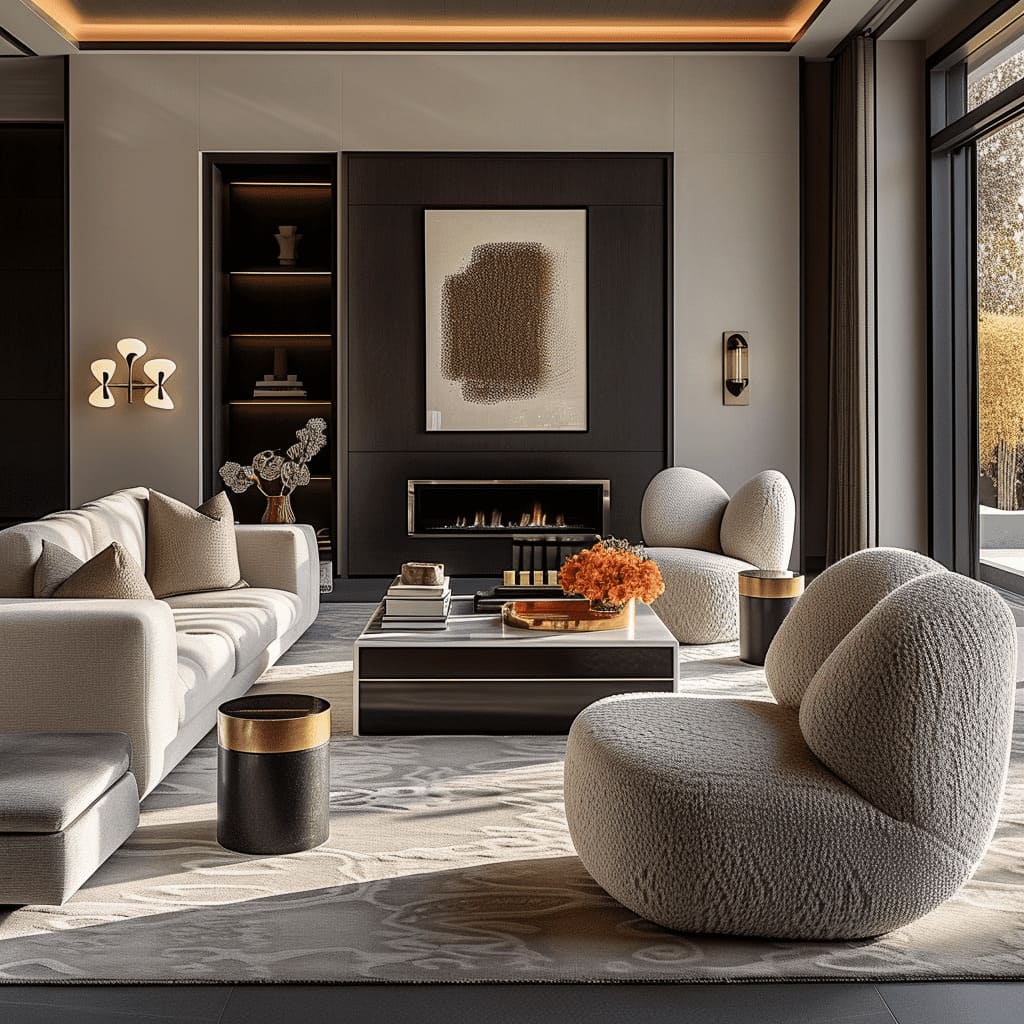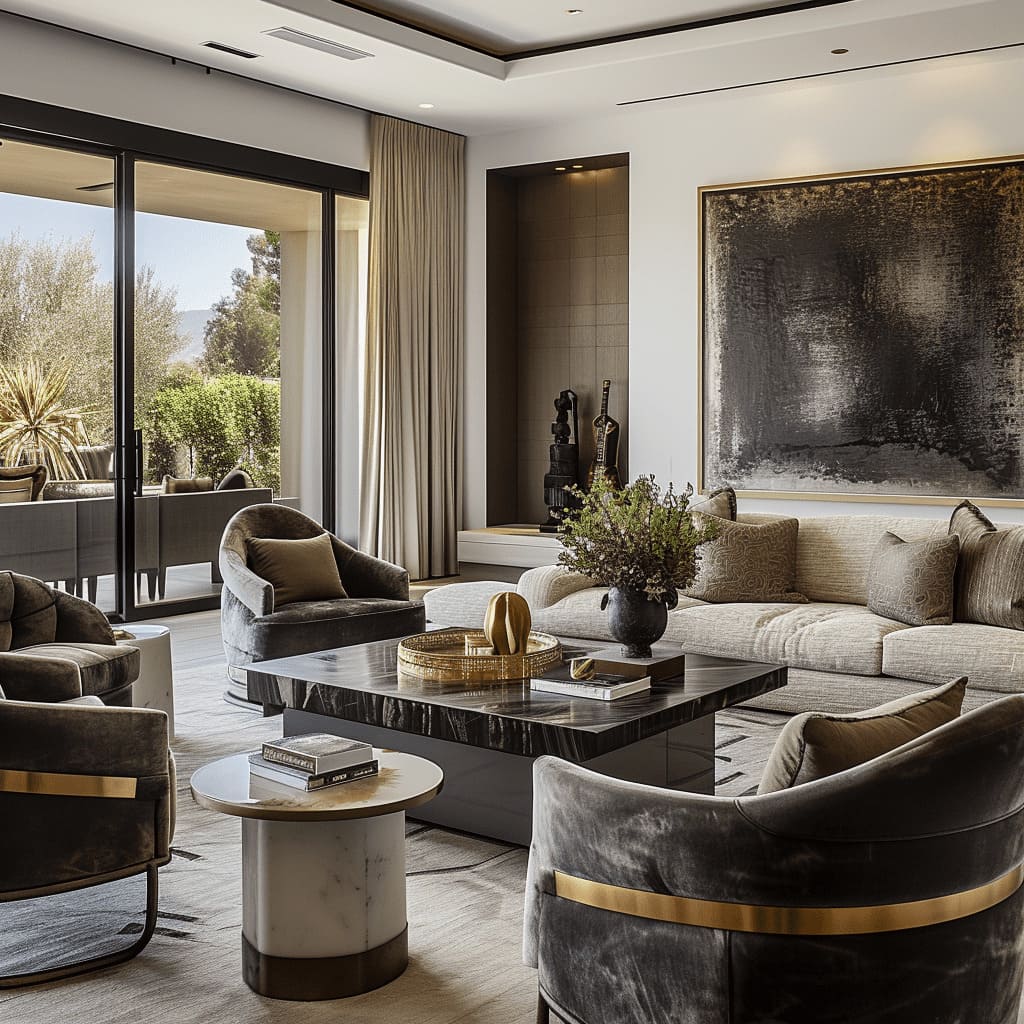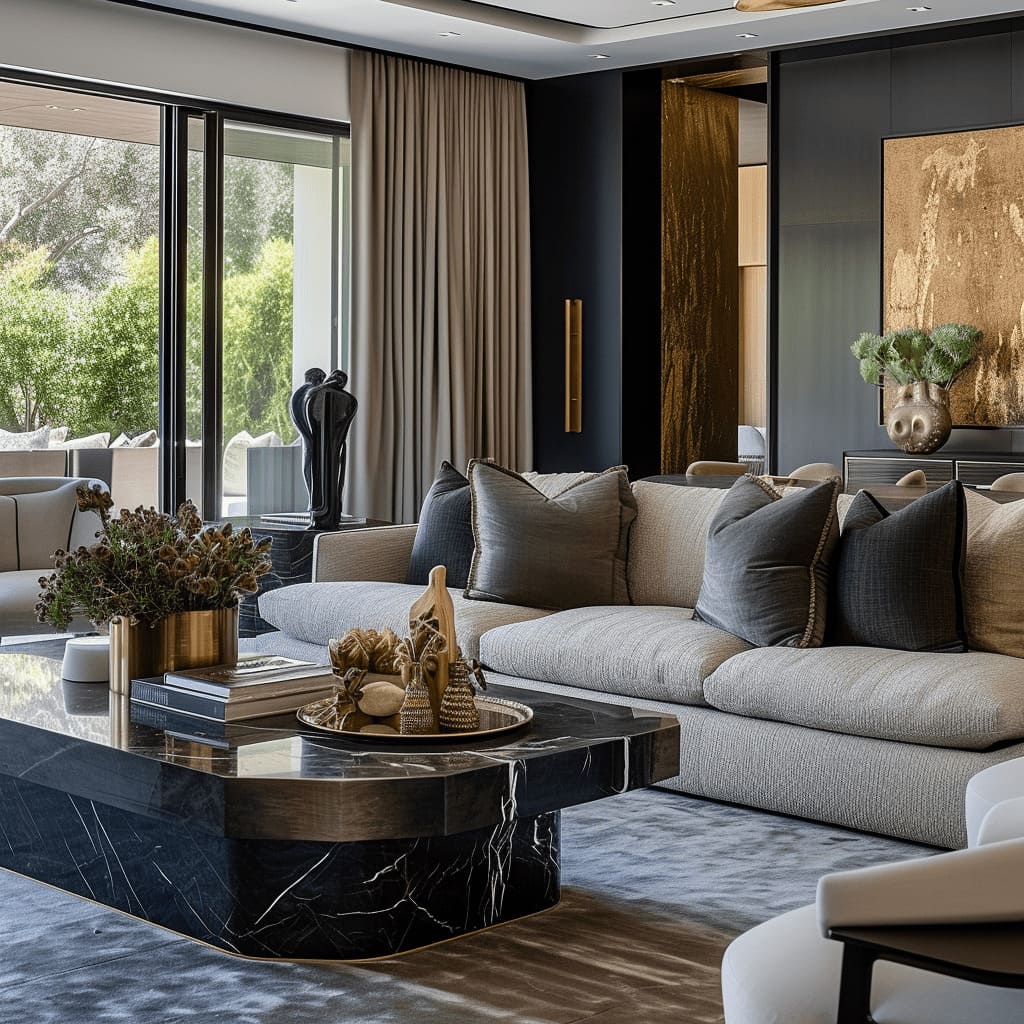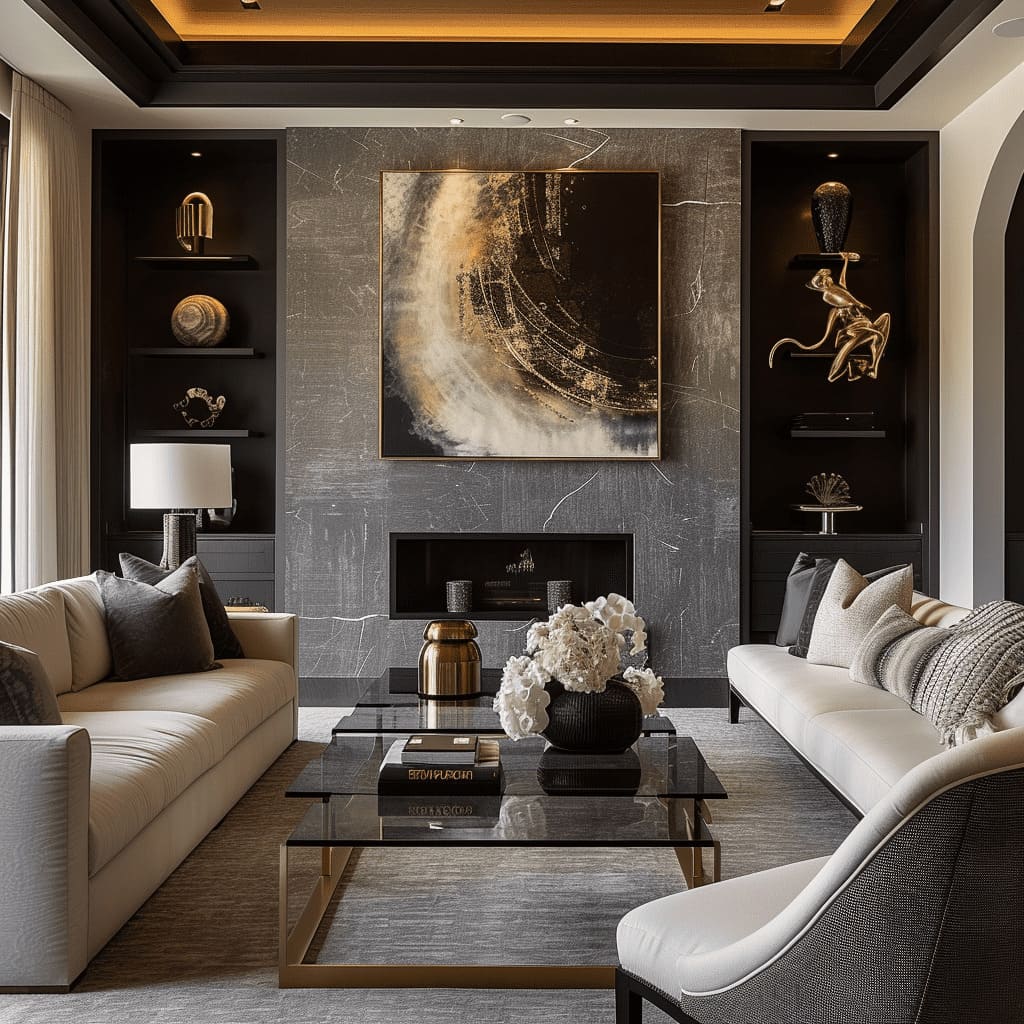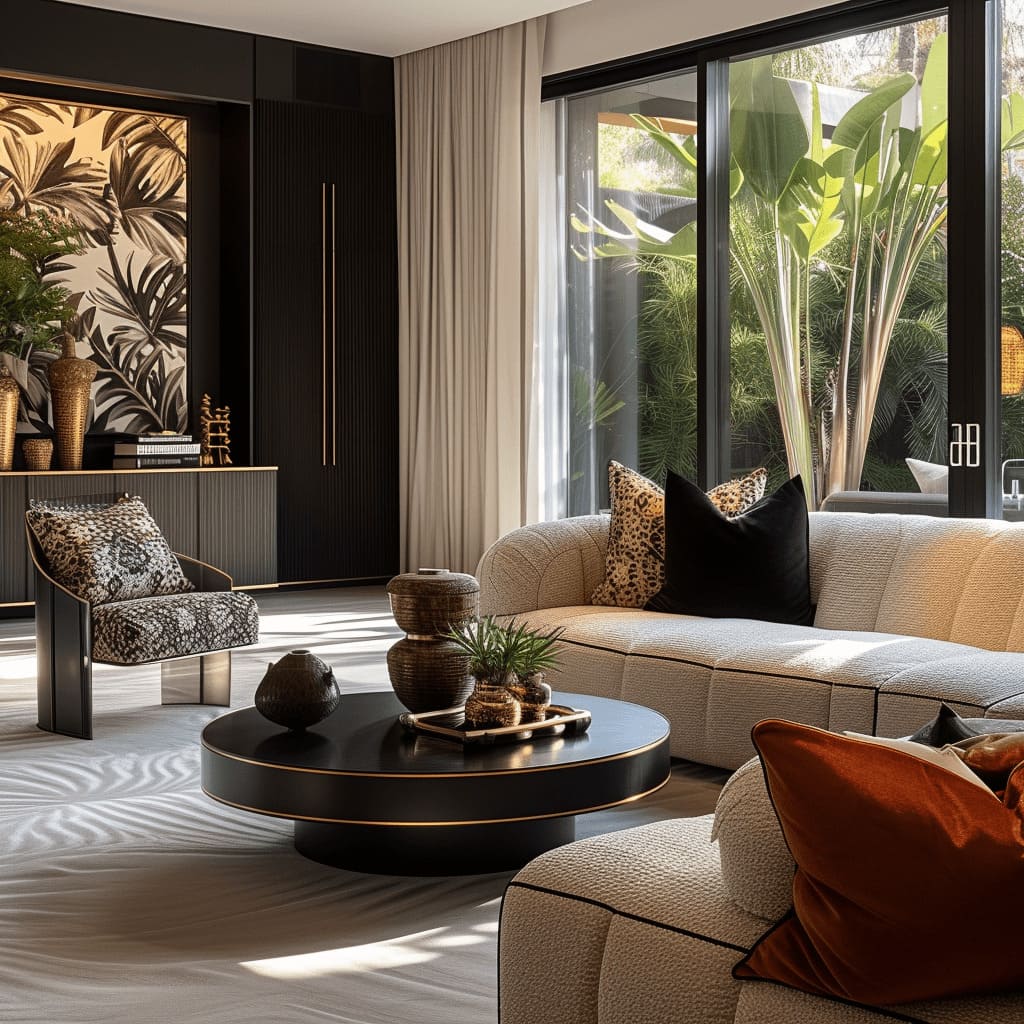Welcome to the world of refined elegance, where the art of interior design transcends mere aesthetics to become a statement of luxury and personalized style. This article is about bespoke contemporary luxury interiors, showcasing spaces that exemplify the pinnacle of modern design.
Each living room we explore is a testament to high-quality materials, custom craftsmanship, sophisticated color palettes, and thoughtful layering of textures and lighting. As we delve into the intricate details that make these interiors stand out, we reveal the secrets behind creating a harmonious environment that resonates with comfort, elegance, and modernity.
Custom Furniture and Built-Ins:
Bespoke furniture pieces that are tailor-made for the space not only ensure a perfect fit but also provide an opportunity for uniqueness and personal expression. Built-in shelves and cabinets are often designed to blend seamlessly with the walls, providing a sleek and uncluttered look while offering functional storage solutions.
The designs showcase furniture that is not only custom in size but also in design, with each piece contributing to the room’s narrative. The sofas and chairs are often of a scale that maximizes comfort without sacrificing form, upholstered in luxurious fabrics that invite touch.
Built-in units are crafted with precision, their color and finish coordinated with the room’s palette, and their form follows the architectural lines of the space, reinforcing the design intent.
These built-ins often feature specialized lighting to showcase displayed items and to add a warm glow to the room. The custom nature of these pieces allows for the incorporation of unique materials and finishes, such as inlaid wood, brushed metal, or lacquer, that can echo other design elements within the space.
To achieve this level of customization, collaboration with skilled craftsmen and designers is key. These professionals can take the vision for a space and translate it into reality, creating pieces that are both beautiful and perfectly suited to the intended environment.
For those looking to incorporate custom furniture and built-ins, it’s important to consider the overall design goals and to work with the space, not against it. Custom work allows for the creation of pieces that fit the exact dimensions and functional needs of a room, ensuring that no space is wasted and that the aesthetic flow is uninterrupted.
Layered Textures:
In luxury interiors, a variety of textures are used to create a rich and inviting environment. This can include a mix of smooth and rough surfaces, glossy and matte finishes, and a combination of textiles such as silk, velvet, and wool.
Rugs, throws, and cushions add comfort and warmth, contributing to a multi-sensory experience. The interiors depict a masterful interplay of textures, with plush rugs underfoot, sumptuous velvet seating, and sleek marble tabletops.
This tactile diversity is not random but carefully curated to provide contrast and depth. For instance, a smooth, polished stone floor may be softened by a thick, woven area rug, while a glossy, lacquered side table could be paired with a matte-finished lamp.
The layering of textiles is particularly evident in the selection of cushions and throws, which vary not only in material but also in pattern and pile. Some cushions feature delicate embroidery or beading, while others boast a simpler, velvety texture.
Throws are casually draped over seating, their knits or furs adding an element of coziness.
To incorporate layered textures into your own space, begin with a base texture and build from there, considering how each texture will interact with the others. It’s important to balance the textures so that they complement rather than compete with each other.
Consider the tactile as well as the visual; luxury is as much about how a space feels as how it looks. Select textiles that will not only add visual interest but will also enhance the comfort of the room.
Varying textures within a cohesive color palette can create a sense of unity and flow throughout the space, adding to the overall luxury experience.
High-Quality Materials:
Luxurious interiors frequently use materials that are both aesthetically pleasing and of high quality. This includes the use of rich textiles for curtains and upholstery, natural stone for countertops and accent walls, and premium woods for flooring and furniture.
These materials not only provide a sense of luxury but also ensure durability and longevity. To elaborate, the textiles selected often feature intricate weaves or embroidery that add texture and visual interest to the space.
The upholstery exhibits exceptional craftsmanship, with attention to the tactile experience, as well as visual appeal. Similarly, the use of natural stone like marble or quartz in the countertops or accent walls is not just about their beauty, but also about the touch of elegance they bring with their unique veins and natural patterns.
Premium woods such as walnut, oak, or mahogany are chosen for their grain patterns and finishing, contributing to the overall aesthetic. The furniture pieces showcase the natural beauty of the wood, highlighting the organic patterns with high-gloss or matte finishes for a contemporary edge.
Incorporating such materials into your living space requires a discerning eye for quality and a commitment to maintenance. These materials demand regular care to maintain their luxurious appearance but reward you with their timeless beauty and enduring presence.
For those seeking to emulate these features, it’s essential to invest in high-grade textiles, authentic stone surfaces, and quality woodwork from reputable sources.
Elegant Color Palettes:
A sophisticated color scheme is central to luxury interior design. Neutral tones like creams, beiges, grays, and blacks are often combined to create a timeless and elegant ambiance.
Accents of more saturated colors may be used to add depth and interest to the space. Metallic tones, such as gold, silver, and bronze, are also commonly used to impart a sense of opulence.
We see a masterful use of neutral palettes that serve as a canvas for the rooms’ architectural details and fine furnishings. These foundational hues promote a sense of calm and spaciousness.
The judicious use of bolder colors, like the burnt orange or deep blue seen in some of the accent pillows and artwork, introduces a dynamic element without overwhelming the senses.
Metallic accents are strategically placed throughout the rooms in the form of lamp bases, coffee table frames, and decorative objects. These reflective surfaces catch the light and contribute to the overall luminosity of the space.
They bridge the gap between functionality and aesthetics, serving as both decorative elements and light-enhancing components.
To replicate such an elegant color palette, one should start with a base of neutral tones for walls and large furniture pieces. Introduce color through accessories, artwork, or a feature wall, allowing for flexibility in changing trends or personal tastes.
Metallic accents should be used sparingly to maintain a refined look; too much can take away from the desired sophistication. Choose quality paints with rich pigments and consider custom or designer pieces that can act as the cornerstone of your color scheme.
Statement Lighting:
Lighting is a critical element in luxury interiors. It’s not only about illuminating the space but also about creating a mood and highlighting architectural and design elements.
Chandeliers and pendant lights, often with unique designs or made from luxurious materials, serve as focal points and can add a dramatic effect to the room.
The designs illustrate this principle beautifully, showcasing lighting fixtures that are not mere utilities but works of art in themselves. The chandeliers are grand, with intricate designs that could range from modern geometric shapes to more classical or ornate styles.
They are positioned to not only light the room but also to enhance the room’s visual appeal. Recessed and cove lighting are used to create layers of illumination, highlighting textured walls and architectural details.
In addition to their functional role, these lighting elements can alter the atmosphere of a room, making it feel warm and intimate or open and airy, depending on their placement and the light they emit. Dimmable lights are often incorporated to adjust the ambiance to suit different occasions or times of day.
Carefully selected table and floor lamps contribute to the layered lighting design, providing task lighting and adding to the overall aesthetic.
For those looking to integrate statement lighting into their interiors, consider the scale of the space and the height of the ceilings when selecting fixtures. A bold piece may serve as a stunning centerpiece in a grand room, while several smaller, but equally striking fixtures can be used to draw the eye throughout a more modest space.
Investing in high-quality, designer lighting can have a transformative effect on an interior, elevating it from ordinary to extraordinary.
Artistic Elements and Accessories:
High-end interiors often feature curated pieces of art, whether it’s large paintings, sculptures, or designer objects. These elements serve as conversation pieces and reflect the personal taste of the homeowner.
Additionally, decorative accessories like vases, books, and ornamental bowls add layers and texture to the design.
The living spaces are exemplified by the presence of bold artwork that commands attention. The paintings are often large-scale, making a statement with their size as well as their subject matter.
They can be abstract, providing a splash of color or texture, or figurative, adding a narrative element to the room. Sculptures are chosen for their form and material, offering a 3D counterpart to the two-dimensional art on the walls.
Decorative accessories are not chosen at random; each book, vase, and ornamental object is selected for its ability to complement the room’s color scheme and design theme. They are placed in groups to create vignettes, with an emphasis on varying heights, shapes, and textures to keep the eye moving and interested.
These accessories also serve a functional purpose, like housing floral arrangements or storing small items.
Incorporating artistic elements and accessories into one’s own space requires a thoughtful approach. One should start by selecting art that resonates personally, as these pieces will be the soul of the room.
When choosing accessories, consider the balance and proportion in relation to other items and the space as a whole. Remember, in a luxurious setting, less is often more; a few well-chosen pieces will have greater impact than a multitude of average items.
Seek out unique objects that not only fill a space but also tell a story or evoke an emotion.
As we conclude our exploration of these meticulously crafted spaces, it becomes clear that contemporary luxury is not just a style but an experience. The interiors we’ve journeyed through demonstrate a deep understanding of design harmony, where every element serves a purpose, and beauty intertwines with functionality.
From the bespoke furniture that fits like a glove in its designated space to the strategic use of textures that delight the senses, these living rooms are masterclasses in interior design. They stand as a source of inspiration for anyone looking to infuse their home with a touch of contemporary luxury, offering a canvas upon which personal expression and sophisticated taste can paint their own unique story.


